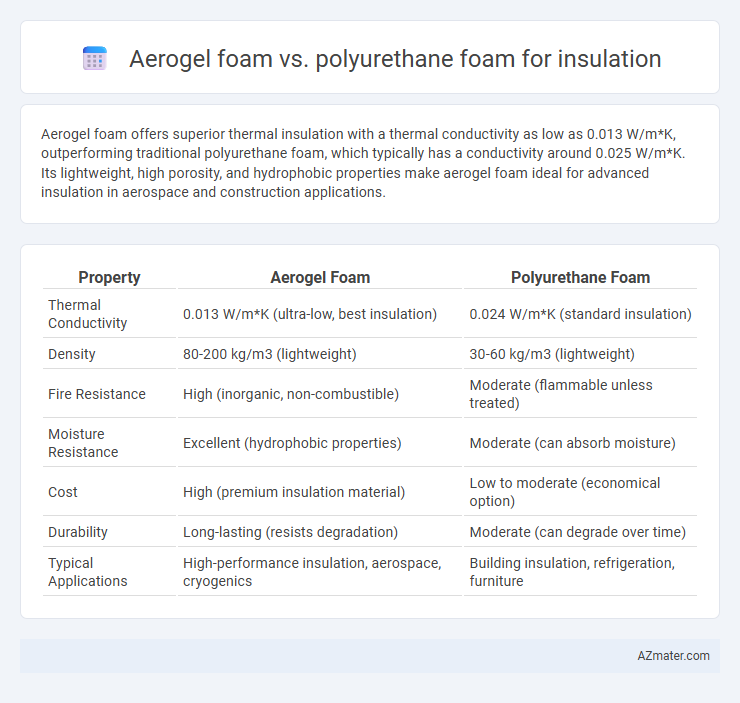Aerogel foam offers superior thermal insulation with a thermal conductivity as low as 0.013 W/m*K, outperforming traditional polyurethane foam, which typically has a conductivity around 0.025 W/m*K. Its lightweight, high porosity, and hydrophobic properties make aerogel foam ideal for advanced insulation in aerospace and construction applications.
Table of Comparison
| Property | Aerogel Foam | Polyurethane Foam |
|---|---|---|
| Thermal Conductivity | 0.013 W/m*K (ultra-low, best insulation) | 0.024 W/m*K (standard insulation) |
| Density | 80-200 kg/m3 (lightweight) | 30-60 kg/m3 (lightweight) |
| Fire Resistance | High (inorganic, non-combustible) | Moderate (flammable unless treated) |
| Moisture Resistance | Excellent (hydrophobic properties) | Moderate (can absorb moisture) |
| Cost | High (premium insulation material) | Low to moderate (economical option) |
| Durability | Long-lasting (resists degradation) | Moderate (can degrade over time) |
| Typical Applications | High-performance insulation, aerospace, cryogenics | Building insulation, refrigeration, furniture |
Introduction to Aerogel and Polyurethane Foams
Aerogel foam, renowned for its ultra-low thermal conductivity of around 0.013 W/m*K, offers exceptional insulation performance due to its nanoporous structure that minimizes heat transfer. Polyurethane foam, widely used in construction and refrigeration, provides effective insulation with a thermal conductivity typically between 0.02 and 0.03 W/m*K, balancing cost and performance. Both materials serve crucial roles in energy efficiency, but aerogel foam excels in extreme insulation applications thanks to its superior thermal resistance and lightweight properties.
Composition and Material Science
Aerogel foam consists primarily of silica nanoparticles arranged in a highly porous nanostructure, offering extremely low thermal conductivity and superior insulating properties due to its high surface area and minimal solid content. Polyurethane foam is a polymeric material formed from the reaction of polyols and diisocyanates, incorporating closed-cell structures that trap gases to reduce heat transfer but with higher density and thermal conductivity compared to aerogel. Material scientists emphasize aerogel's nanoscale porosity as optimizing insulation at extreme temperatures, while polyurethane's chemical versatility allows for cost-effective, scalable insulation with moderate thermal resistance.
Thermal Insulation Performance
Aerogel foam offers superior thermal insulation performance with thermal conductivity as low as 0.013 W/m*K, significantly outperforming polyurethane foam, which typically ranges from 0.022 to 0.028 W/m*K. This ultra-low thermal conductivity of aerogel foam enables better heat resistance and energy efficiency in industrial and building applications. Despite its higher cost, aerogel foam's thin profile and enhanced insulating properties make it ideal for space-constrained environments requiring maximum thermal protection.
Weight and Density Comparison
Aerogel foam, known for its ultra-low density ranging from 0.003 to 0.1 g/cm3, offers significantly lighter weight insulation compared to polyurethane foam, which typically has a density between 0.03 and 0.06 g/cm3. The exceptional porosity of aerogel foam results in superior thermal insulation performance at a fraction of the weight of polyurethane foam. This weight advantage makes aerogel foam ideal for applications requiring minimal load, such as aerospace and high-performance building insulation.
Moisture and Fire Resistance
Aerogel foam offers superior moisture resistance due to its hydrophobic properties, preventing water absorption and maintaining insulation effectiveness even in humid environments. Polyurethane foam is more susceptible to moisture infiltration, which can degrade its insulating performance over time. In terms of fire resistance, aerogel foam exhibits higher thermal stability and low flammability, while polyurethane foam typically requires added fire retardants to meet safety standards.
Durability and Longevity
Aerogel foam offers superior durability and longevity compared to polyurethane foam due to its resistance to moisture, high temperatures, and compression, maintaining insulation performance over extended periods. Polyurethane foam, while cost-effective and widely used, tends to degrade faster under environmental stressors such as UV exposure and humidity, leading to reduced effectiveness and the need for replacement. The high structural stability and thermal resistance of aerogel foam make it a prime choice for long-term insulation solutions in both industrial and residential applications.
Environmental Impact and Sustainability
Aerogel foam offers superior thermal insulation with a lower environmental footprint due to its high efficiency, leading to reduced energy consumption and greenhouse gas emissions over its lifecycle compared to polyurethane foam. Polyurethane foam production relies heavily on petroleum-based chemicals and releases volatile organic compounds (VOCs), posing greater environmental and health concerns. Aerogel's recyclability and durability further enhance its sustainability profile, making it a preferred option for eco-conscious insulation solutions.
Cost Analysis and Economic Considerations
Aerogel foam offers superior thermal insulation with an R-value of approximately 10 per inch, significantly outperforming polyurethane foam, which typically has an R-value around 6 to 7 per inch, but aerogel's cost ranges from $20 to $30 per square foot compared to polyurethane's $1 to $3. The high upfront cost of aerogel can be offset by long-term energy savings in commercial and industrial applications where thermal efficiency is critical. Economic feasibility studies often favor polyurethane foam for residential projects due to its lower initial investment, while aerogel foam is preferred in specialized settings requiring minimal thickness and exceptional insulation performance despite its premium price.
Typical Applications and Use Cases
Aerogel foam excels in high-performance insulation applications such as aerospace, industrial pipelines, and cryogenics due to its ultra-low thermal conductivity and lightweight properties. Polyurethane foam is widely used in residential and commercial building insulation, refrigeration, and automotive industries for its cost-effectiveness and good thermal resistance. Both materials serve distinct use cases where aerogel prioritizes extreme insulation efficiency and polyurethane offers affordability and ease of application.
Future Trends in Foam Insulation Technologies
Aerogel foam offers superior thermal insulation with low density and high porosity, making it ideal for energy-efficient building envelopes, while polyurethane foam remains popular due to cost-effectiveness and versatility. Future trends highlight the development of hybrid foams combining aerogel's thermal performance with polyurethane's mechanical strength, aiming to enhance durability and reduce environmental impact. Innovations in bio-based and recycled materials are also driving sustainable foam insulation solutions, meeting increasing regulatory demands for eco-friendly building products.

Infographic: Aerogel foam vs Polyurethane foam for Insulation
 azmater.com
azmater.com